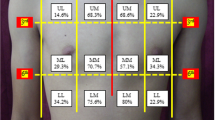Abstract
Purpose
Modern lung ultrasound (US) is mainly applied not only in critical care, emergency medicine, and trauma surgery, but also in pulmonary and internal medicine. In some cases, pneumothorax (PTX) distinguishes with bullous diseases. In this study, we aimed to discuss the success of US on detecting PTX versus bullae.
Methods
We performed a prospective blinded study. Patients underwent thorax computed tomography (CT) if bullae or pneumothorax could not be differentiated from the chest radiography. An emergency medicine specialist trained in lung US and unaware of x-ray and CT findings performed US. All patients US performed from anterior and lateral wall.
Results
Final study population included 81 patients. The sensitivity of the presence of pleural sliding in the diagnosis of bullae was 97.50% (86.84–99.94%), and specificity was 100.0% (91.4–100.0%).
Conclusion
In conclusion, direct visualisation of ultrasonographic pleural sliding can be a good tool for differentiating bullae and pneumothorax.


Similar content being viewed by others
References
Bobbio A, Dechartres A, Bouam S, Damotte D, Rabbat A, Regnard JF, Roche N, Alifano M (2015) Epidemiology of spontaneous pneumothorax: gender-related differences. Thorax 70(7):653–658
Gupta D, Hansell A, Nichols T, Duong T, Ayres JG, Strachan D (2000) Epidemiology of pneumothorax in England. Thorax 55(8):666–671
Deslauriers J, Leblanc P (1994) Management of bullous disease. Chest Surg Clin N Am 4(3):539–559
Volpicelli G, Elbarbary M, Blaivas M, Lichtenstein DA, Mathis G, Kirkpatrick AW et al (2012) International evidence-based recommendations for point-of-care lung ultrasound. Intensive Care Med 38(4):577–591
Volpicelli G (2011) Sonographic diagnosis of pneumothorax. Intensive Care Med 37(2):224–232
Lichtenstein D, Meziere G, Biderman P, Gepner A (2000) The “lung point”: an ultrasound sign specific to pneumothorax. Intensive Care Med 26(10):1434–1440
Gelabert C, Nelson M (2015) Bleb point: mimicker of pneumothorax in bullous lung disease. West J Emerg Med 16(3):447–449
Mitlehner W, Friedrich M, Dissmann W (1992) Value of computer tomography in the detection of bullae and blebs in patients with primary spontaneous pneumothorax. Respiration 59(4):221–227
Feletti F, Mucci V, Aliverti A (2018) Chest ultrasonography in modern day extreme settings: from military setting and natural disasters to space flights and extreme sports. Can Respir J 2018:1–9
Karim A, Arora VK (2014) Applications of ultrasonography in respiratory intensive care. Indian J Chest Dis Allied Sci 56(1):27–31
Lee FC (2016) Lung ultrasound-a primary survey of the acutely dyspneic patient. J Intensive Care 4(1):57
Patel CJ, Bhatt HB, Parikh SN, Jhaveri BN, Puranik JH (2018) Bedside lung ultrasound in emergency protocol as a diagnostic tool in patients of acute respiratory distress presenting to emergency department. Journal of Emergencies, Trauma, and Shock 11(2):125–129
Blaivas M, Lyon M, Duggal S (2005) A prospective comparison of supine chest radiography and bedside ultrasound for the diagnosis of traumatic pneumothorax. Acad Emerg Med 12(9):844–849
Targhetta R, Bourgeois JM, Chavagneux R, Coste E, Amy D, Balmes P, Pourcelot L (1993) Ultrasonic signs of pneumothorax: preliminary work. J Clin Ultrasound 21(4):245–250
Ciccarese F, Chiesa AM, Feletti F, Vizioli L, Pasquali M, Forti P, Zoli M, Zompatori M (2015) The senile lung as a possible source of pitfalls on chest ultrasonography and computed tomography. Respiration 90(1):56–62
Chiesa AM, Ciccarese F, Gardelli G, Regina UM, Feletti F, Bacchi Reggiani ML, Zompatori M (2015) Sonography of the normal lung: comparison between young and elderly subjects. J Clin Ultrasound 43(4):230–234
Lichtenstein D, Meziere G, Biderman P, Gepner A (1999) The comet-tail artifact: an ultrasound sign ruling out pneumothorax. Intensive Care Med 25(4):383–388
Simon BC, Paolinetti L (2005) Two cases where bedside ultrasound was able to distinguish pulmonary bleb from pneumothorax. The Journal of emergency medicine 29(2):201–205
Lichtenstein D, Meziere G, Biderman P, Gepner A, Barre O (1997) The comet-tail artifact: an ultrasound sign of alveolar-interstitial syndrome. Am J Respir Crit Care Med 156(5):1640–1646
Lichtenstein DA, Mezière GA, Lagoueyte J-F, Biderman P, Goldstein I, Gepner A (2009) A-lines and B-lines: lung ultrasound as a bedside tool for predicting pulmonary artery occlusion pressure in the critically ill. CHEST Journal 136(4):1014–1020
Johnson A (2009) Emergency department diagnosis of pneumothorax using goal-directed ultrasound. Acad Emerg Med Off J Soc Acad Emerg Med 16(12):1379–1380
Funding
This research received no specific grant from any funding agency in the public, commercial, or not-for-profit sectors. All data and materials used in this study are available.
Author information
Authors and Affiliations
Contributions
Design of the work Sinan Karacabey, Sercan Yalcinli
Data collection Bayram Metin, Yavuz Selim Intepe, Fatih Erkoc, Sener Yildirim
Data Analysis Erkman Sanrı, Sener Yildirim
Drafting Article Sinan Karacabey, Erkman Sanrı
Revised and approved the version to be published Bayram Metin, Yavuz Selim Intepe, Fatih Erkoc
Corresponding author
Ethics declarations
Conflict of interest
The authors declare that they have no conflict of interest.
Informed consent
Written informed consent was obtained from patients for this study.
Ethical approval
Ethical approval was obtained from the institutional review boards (604-02). The study protocol conforms to the ethical guidelines of the 1975 Declaration of Helsinki as reflected in a priori approval by the institution’s human research committee.
Rights and permissions
About this article
Cite this article
Karacabey, S., Sanri, E., Metin, B. et al. Use of ultrasonography for differentiation between bullae and pneumothorax. Emerg Radiol 26, 15–19 (2019). https://doi.org/10.1007/s10140-018-1640-9
Received:
Accepted:
Published:
Issue Date:
DOI: https://doi.org/10.1007/s10140-018-1640-9




